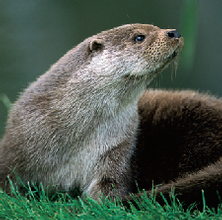

Biodiversity
Action
Plan
Otter conservation
The return of the Otter to most of England is one of the major conservation success stories of the last 30 years.
There is potential through local conservation measures to increase its presence in Barnsley
Reasons for decline and loss
- Water quality - Pollution including agricultural run-off.
- Loss of habitat -Intensification of river management led to habitat loss .
- Insufficient food - Lower water quality results in a reduced fish stocks.
- Accidental death - especially road traffic accidents.
- Disturbance - Otters need some quiet areas for resting and breeding.
- Population fragmentation - Increasingly, populations are being isolated by new roads, canalisation, development and loss of habitat.
Further information + advice
Standing Advice Otters: surveys and mitigation for development projects
Natural England information
PTES facts & figures national survey
Associated Local Priority Habitats
- Running water, rivers and streams
- Standing water and ponds
- Wet woodland
- Wetlands including Reedbeds

Good practice in conservation management for Otter
A catchment-wide approach is essential. The main drivers for increases in the numbers of Otters have been drops in levels of toxic pesticides, improvements in water quality, and increases in fish stocks.
- Ensuring that water quality is maintained or improved
- Maintaining fish populations in rivers where Otter has returned needs careful management until a balance is restored
- Providing more bankside vegetation and dense scrub cover for resting and breeding sites and keep them undisturbed by fencing them off.
[One ‘lying-in’ site approximately every kilometre of watercourse] - Installing otter holts for breeding and lying-up/resting sites
- Limiting accidental killing of otters by providing underpasses on new and existing roads when appropriate
- Taking account of Otter movement in the development of new roads, upgrading bridges, flood defence works and riverside development and implement mitigation measures.

Legal protection.
Otters are a European Protected Species and fully protected under he Conservation of Habitats and Species Regulations 2017 and Schedule 5 of the Wildlife & Countryside Act 1981.
It is an offence whether on purpose or by not taking enough care to
- capture, kill, disturb or injure an Otter
- damage or destroy a breeding or resting place
- obstruct access to their resting or sheltering places
- possess, sell, control or transport live or dead otter.
It also has the same protection as other mammals from deliberate cruelty under the Wild Mammals Protection Act.
The Otter is a Section 41 species of principal importance for conservation and as such need to be taken into consideration by any public body in managing their estate. NERC Act (2006)
Otter Conservation